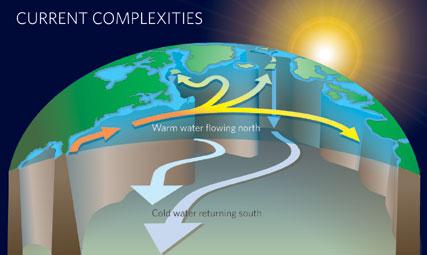 Still flowing: the Atlantic current plays a major role in heat transport on our planet.Getty
Still flowing: the Atlantic current plays a major role in heat transport on our planet.GettyIs the powerful Atlantic current that has a major role in ocean circulation slowing down? We won't know until we have collected more than 20 years' worth of continuous measurements, researchers said on Monday at the general assembly of the European Geoscience Union in Vienna, Austria.
The Atlantic Meridional Overturning Circulation (MOC), a key component of the climate system, is responsible for one-quarter of the global northward transport of heat. It has been under close scrutiny since spring 2004, when ocean scientists set in operation an array of more than 20 instruments moored on the ocean floor between the Bahamas and the Canary Islands, as part of the international Rapid Climate Change (RAPID) programme.
Scientists have reason to suspect that this current is slowing — a process that could cause massive changes in climate to northern Europe, and have untold knock-on effects around the globe thanks to a huge shift in the heat distribution on the planet.
One study1, published in 2005, looked at five sets of ship-based measurements made between 1957 and 2004, and hinted at an alarming 30% reduction of the MOC during that period. Models have predicted2 that this magnitude of slowing might take place by 2100, not by 2004. But the error estimates in the 2005 study were very large, and it was unclear whether it was a true trend or just a blip.
“With existing observations we can not distinguish between natural variability and a possible long-term downward trend.”
Johanna Baehr, MIT.
Johanna Baehr, a physical oceanographer formerly at the Max Planck Institute of Meteorology in Hamburg, Germany, has now shown that with this type of information — snapshots from shipboard measurements carried out every 10 to 20 years — it would take well over a century to reliably detect a 30% reduction of the flow.
The RAPID array is a huge improvement in that the moored instruments measure ocean temperature and salinity every 20 minutes. But Baehr, who is now at the Massachusetts Institute of Technology in Cambridge, calculates that even with these continuous measurements it will take 20-30 years to detect a statistically significant trend.
"With existing observations we cannot distinguish between natural variability and a possible long-term downward trend," she says.
Long-term plan

The first two years of RAPID observations can't reveal any long-term trends, but do suggest that the variability of the MOC over time is larger than had been previously assumed. That makes spotting a trend quite difficult.
RAPID is measuring the annual mean flow of the current to the precision of 1.5 million cubic metres per second; by comparison, models predict a reduction in flow of about 5 million to 10 million cubic metres per second by 2050. This precision is sufficient to be able to immediately detect an unlikely abrupt collapse of the MOC. But for the more likely scenario of a gradual slowdown, the array would need to remain operational at least twice as long as is currently planned, says Baehr. The programme is currently funded until 2014.
That's already a relatively long commitment period, notes Stuart Cunningham, a principal investigator in the RAPID programme at the National Oceanography Centre in Southampton, UK. The UK agency supporting the programme (the Natural Environment Research Council) "has never funded any programme for so long", he says. And there is no UK agency for long-term funding of operational oceanography, he says. To ensure longer funding, he says, "we basically would need a new agency."
ADVERTISEMENT
The array is threatened by various activities that break the instruments, including
illegal fishing off the African coast, and hurricanes. On average, a couple of emergency missions to fix the moors are needed each year. "But RAPID is designed with enough redundancy to always remain operational," says Cunningham.
Visit our neededtotellwhether.html">newsblog to read and post comments about this story.
